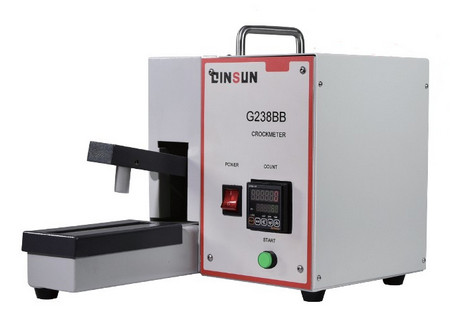
NewsInformation Center
Aatcc Crocking Testing Meter Electronic Gray Scale Textile Crockmeter
2023/09/12
A crockmeter, also known as a crocking tester or rubbing fastness tester, is a device used to evaluate the colorfastness or transfer of color from a dyed or printed fabric to other surfaces by rubbing. The term "crocking" refers to the tendency of color to transfer from one material to another through rubbing.
What is the principle of crockmeter?
Apologies for the earlier confusion. The principle of a crockmeter is based on assessing the colorfastness or transfer of color from a dyed or printed fabric to other surfaces through rubbing.The crockmeter simulates the rubbing or friction that can occur during the use or handling of fabrics, helping to determine their colorfastness and resistance to color transfer. The main principle involves the following steps:
1. Sample Preparation: A fabric sample is selected and prepared for testing. This typically involves cutting it into a specific size and shape, removing loose fibers, and ensuring a standardized testing area.
2. Rubbing Procedure: The fabric sample is securely mounted on the stationary platform of the crockmeter. A rubbing finger or pad, often made of a standardized material like uncolored cotton cloth or a specialized fabric, is applied to the surface of the fabric with a specified load or pressure. The rubbing finger or pad is then moved back and forth in a controlled, repetitive motion.
3. Rubbing Parameters: The test parameters, such as the number of rubs, rubbing speed, and applied pressure, are determined based on relevant standard methods or specific testing requirements. These parameters help ensure consistency and repeatability of the test results.
4. Color Evaluation: After the rubbing process, the color transfer is assessed. This evaluation can be conducted visually by comparing the fabric's staining on a standardized white cloth or by using color measurement instruments, such as colorimeters or spectrophotometers, to measure any quantifiable color change.
Based on the level of color transfer observed, the crockmeter test provides an indication of the fabric's colorfastness and its potential for transferring color to other surfaces during rubbing or friction. This information is valuable for manufacturers, textile industries, and quality control laboratories to assess and improve the durability and performance of dyed or printed fabrics.
What is the crockmeter test method?
The crockmeter test method involves a series of steps to assess the colorfastness or color transfer of a fabric through rubbing. Here is a general outline of the crockmeter test method:
1. Sample Preparation: Cut the fabric sample into a specific size and shape, typically a rectangle or square. Remove loose fibers or debris from the surface of the sample.
2. Mounting the Sample: Attach or secure the fabric sample onto the stationary platform of the crockmeter. Ensure that the sample is taut and free from wrinkles or folds.
3. Rubbing Procedure: Place a rubbing finger or pad, made of a standardized material like uncolored cotton cloth or a specialized fabric, on top of the fabric sample. Apply a specified load or pressure to initiate rubbing.
4. Rubbing Parameters: Set the rubbing parameters according to the desired testing standards or specific requirements. This includes determining the number of rubs, rubbing speed, and applied pressure. These parameters may differ based on the industry, fabric type, or testing specifications.
5. Rubbing Motion: Actuate the crockmeter to perform a back-and-forth rubbing motion with the rubbing finger or pad. The rubbing can be in a straight line or a circular pattern, depending on the specific test method.
6. Color Evaluation: After the rubbing process, evaluate the color transfer or staining on the fabric sample and any standardized white cloth used. This evaluation can be done visually by comparing the level of color transfer or staining. Alternatively, quantitative color measurements can be taken using color measurement instruments like colorimeters or spectrophotometers.
7. Reporting Results: Record and report the test results based on the observed color transfer or staining. Results may be reported as a rating or a numerical value, depending on the testing standard or specific requirements.
It is important to note that the exact details and parameters of the crockmeter test method can vary depending on the testing standard, industry specifications, or specific testing requirements. Manufacturers and quality control laboratories follow relevant guidelines and standards to ensure consistent and accurate test results.
Previous: How much does a tensile strength tester machine cost?
N e x t : What is a 6 light color assessment cabinet?




